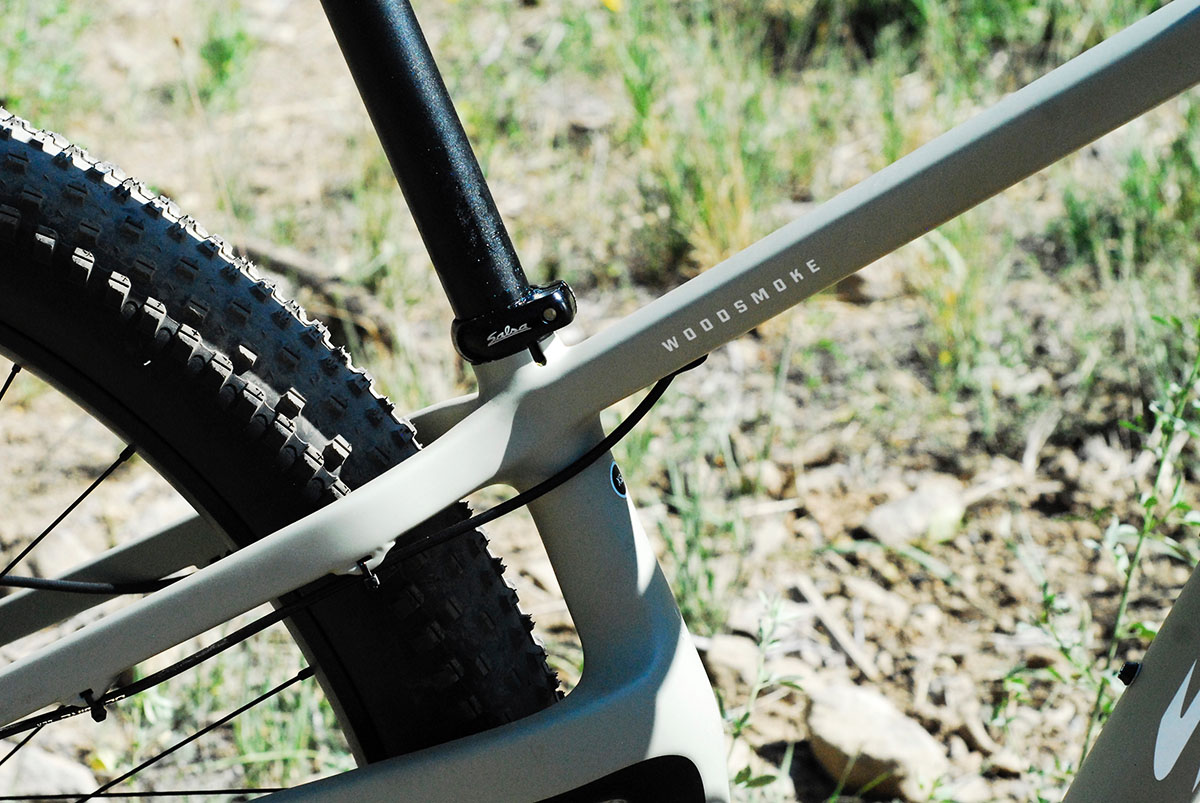With a motto like “Adventure By Bike,” I figured it wouldn’t be long before Salsa Cycles launched a fun, plus-sized hardtail. After all, plus is where it’s at when it comes to off-the-beaten-path adventures. A slightly wider tire provides extra traction and float when navigating chunky stuff, without having quite the rolling resistance and weight of a fat bike.
This year at Saddle Drive in California, my hunch was affirmed when Salsa announced the release of two different hardtails designed specifically around a plus-sized platform. When I first heard about the bikes during a presentation that Salsa did for us our first day on the ground in Tahoe, I couldn’t wait to try out them both.
I rode the Woodsmoke first, a highly-versatile carbon rig designed to run 27.5+, 29″, or 29+ wheels and tires. In addition to a variety of different wheel sizes, it can also easily run from zero to 140mm of travel on the 27.5+ and 29-inch wheels, and up to 120mm on 29+.
The bike comes equipped with Salsa’s new Alternator 2 dropouts. Alternator dropouts on Salsa bikes have long made singlespeed conversions easy, and have allowed for changes in the handling of their bikes by moving the rear wheel forward and back. Lately, with the rise of plus tires and just so many more wheel sizes in general, the alternator dropouts have come in handy for fitting larger wheels in (by moving the wheel back in the dropouts to allow for more frame clearance). A smaller wheel can slide forward to provide more nimble handling. On the Woodsmoke, the Alternator 2 allows for such a variety of wheel sizes to work on the same frame, while keeping the chainstays amazingly short (400-417mm). An elevated chainstay on the driveside, similar to the Trek Stache, allows for further length reduction.
The Woodsmoke is labeled as a “singletrack, bikepacking, off-road exploration” bike–essentially, whatever you want it to be. With 140mm of travel, 27.5+ tires, and a dropper post, this thing is a seriously-playful trail ripper. Go to the other end of the spectrum and set it up with a rigid fork and some 29+ tires, and you’ve got yourself a great long-haul bikepacking rig, worthy of exploits like the Tour Divide. This bike is incredibly adaptable, which seems to be an up and coming theme throughout the industry.
I was pretty interested to ride 29+ and 27.5+ versions back-to-back to see how they would compare. I haven’t previously been super stoked on 29+–probably because I’m a shorter rider (5’3″) and that’s just a lot of wheel. So I decided to give that one a go first to see if my mind could be changed. I elected for an XS at first, because someone had recommended that I go with the smaller size with the 29+. But when I began climbing, I knew it wasn’t right for me. The tiny cockpit put me in a very upright position, and as soon as I began crawling my way up the steep, loose, dusty doubletrack, the front wheel wanted to pop off the ground. I just felt cramped. I rode about halfway up the mountain and back, then swapped it out for the small. But, for the record, I think it’s great that Salsa has recently started offering bikes in a size XS, offering more options for shorter riders.
The small felt much better for me, and I was back in business. On the gravel road, the 29+ tires rolled along easily, keeping up momentum even through the chunky stuff once I hit singletrack. The front end did feel really tall at first before I got used to it–those huge wheels and 120mm fork will do that–but it was surprisingly maneuverable, even on the descent. This was pretty different from the only other 29+ bike I’d ridden, the Surly Krampus, which features a substantially-longer wheelbase. In fact, if I didn’t know better, I might not have even guessed that I was running 29+.
I’d go even as far to say that the bike felt a little twitchy, which probably could have been remedied by moving some spacers around and dropping the bars to find my sweet spot. If I rode this bike for a longer period of time, I’d definitely play around with the cockpit setup.

I jumped on a 27.5+ version immediately afterwards in order to get the best comparison I could, and the smaller wheel size definitely suited me better, especially for the tight turns and descents. While the Woodsmoke 29+ didn’t feel like a 29+, I still prefer a slightly smaller wheel diameter for most of the riding I currently do, and the riding that we were doing at Northstar (which were a lot of trails designed for downhill bikes). However, if I were on a multi-day bikepacking trip and I was carrying my gear for long days and trying to cover a lot of ground, I might want the larger wheel size. I think it’s pretty cool that one bike offers so many options.
Either way, this is a super maneuverable, responsive, and fun bike that’s also great for bikepacking. A large main triangle, even in the smaller sizes, offers plenty of frame bag storage space. There are multiple water bottle mounts, including one on the down tube, and top tube bolts for a bag. The Alternator 2.0 dropouts allow for multiple drivetrain options, whether you want to set it up 1x, 2x, singlespeed, or even belt drive.
What about potential issues? My husband encountered some heel strike on the chainstays, which may be a problem for some riders with larger feet. I didn’t have any probelms on my short test ride, but of course, it’s hard to truly evaluate a bike over the course of only a few miles on unfamiliar terrain and conditions.

Prices are $3,999 for an XO1 build and RockShox Pike, $2,999 for GX1 and a Yari, and $1,999 for NX1 and a Recon. All builds come with alloy Whisky rims, WTB Ranger tires, and SRAM hydraulic brakes. Full specs and geometry can be found here.
























1 Comments
Jul 30, 2018
taller people=29+
shorter people=27.5+
kinda makes sense. Me being 6'5" 29+ is great! :)